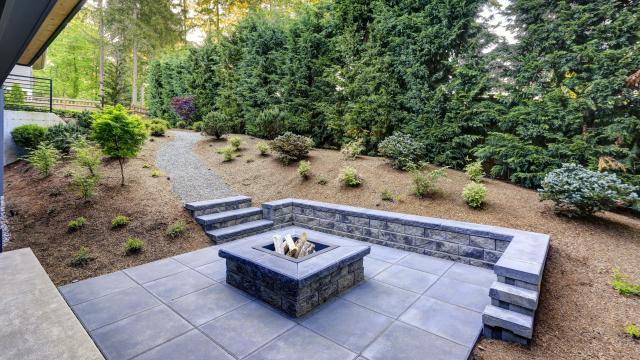Patio pavers are a great landscaping choice because you don’t need to build a structure under them, they’re cheaper than other similar options, and they can add a unique look to your outdoor space. While the flat space can be good for entertaining and relaxing, there are some maintenance headaches when you use pavers instead of decking or a concrete slab. One big problem is that over time, patio pavers can shift because of rain, temperature changes, or weight on top of them. Luckily, there are some things you can do to keep your pavers in place for a seamless patio this season.
Build a solid and level foundation
A firm patio starts with a good foundation, and a good foundation goes deep. To have a firm base, you should dig down and level to between seven and nine inches. Since roots of plants can shift pavers over time, it’s a good idea to dig below the root line of any landscaping plants around the patio. (As always, make sure to call 811 before you dig to avoid hitting buried utility lines.)
If your foundation isn’t level, the pavers can slide because of gravity, so packing down the earth underneath the pavers is key. Using a tamper tool for smaller areas and a dirt compactor for larger ones, level and pack the dirt to keep it from shifting around under the pavers, causing problems later. To check that it’s level, you can use a string stretched around the perimeter between stakes, each tied at the same height and keep the ground surface parallel to the string. Hang a string leveler to get the string exactly level and then tamp down any areas that are bulging or fill in any areas that are depressed. If the patio is adjacent to your house, you should give it a slope away from the structure of at least a quarter inch for every foot, at an angle of about two degrees for drainage.
Use a weed barrier and sweep gravel into the cracks
As mentioned earlier, roots from plant life can cause pavers to shift — plus, weeding your patio isn’t exactly relaxing. Using a good weed barrier beneath the pavers will help keep your patio from sliding around. If you’re using gravel or sand underneath your pavers, you can put the weed barrier between that and the soil.
Filling in cracks between stone pavers with gravel or sand is a key part of keeping the whole system stable. You don’t want any space for the pavers to wander, so raking in some gravel and tamping it into cracks will help keep the base solid. In addition, if you’re using brick or concrete pavers, make sure the pattern fits together snugly to keep things solid. If you have a spot where the pavers don’t fit together tightly, trimming them to fit is the best practice. You can do this using a sawzall with a masonry blade so long as the surface you’re cutting is wet to keep dust down. You should also consider wearing a respirator rated for concrete dust because silica dust can be very damaging to your lungs. You can also use a hand saw to score and snap the pavers if they’re not too thick.
Choose a strong edge
To keep your patio in place, you should build an edge, or use pre-made patio edging. This comes in both vinyl and metal varieties and are attached to the boundaries of your patio with stakes or spikes. You can also build an edge out of pavers that are specially designed to interlock for a stable edge. Keeping the pavers tight together and the plants off of the surface is the goal when you’re making your edge, so this step will act as a fence to keep your pavers in place.

Leave a Reply
You must be logged in to post a comment.